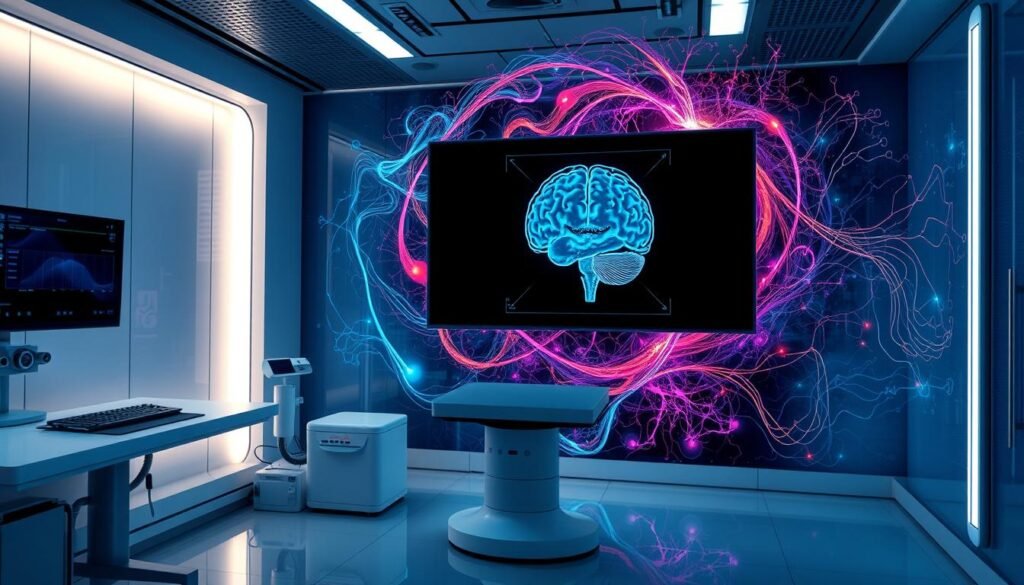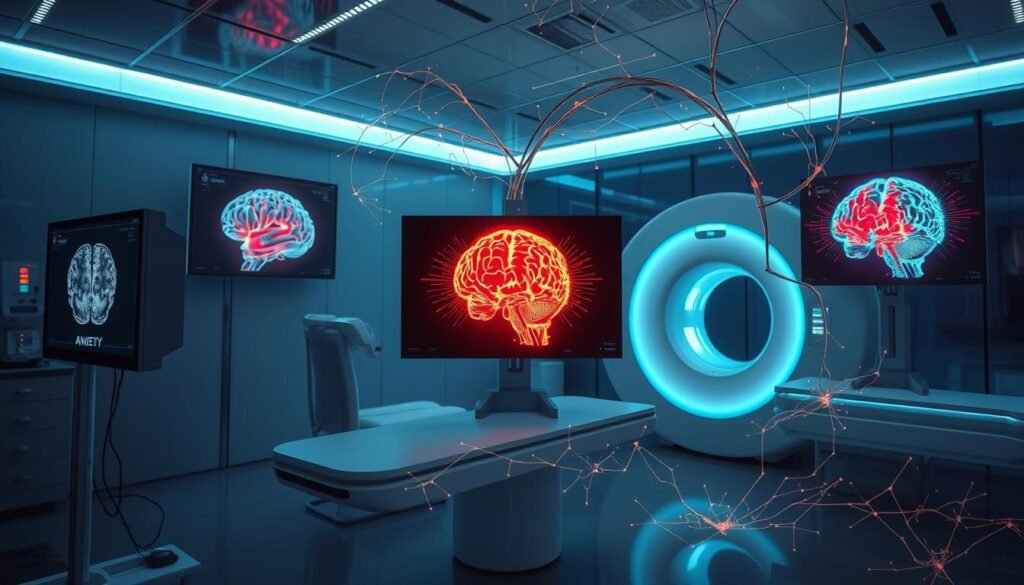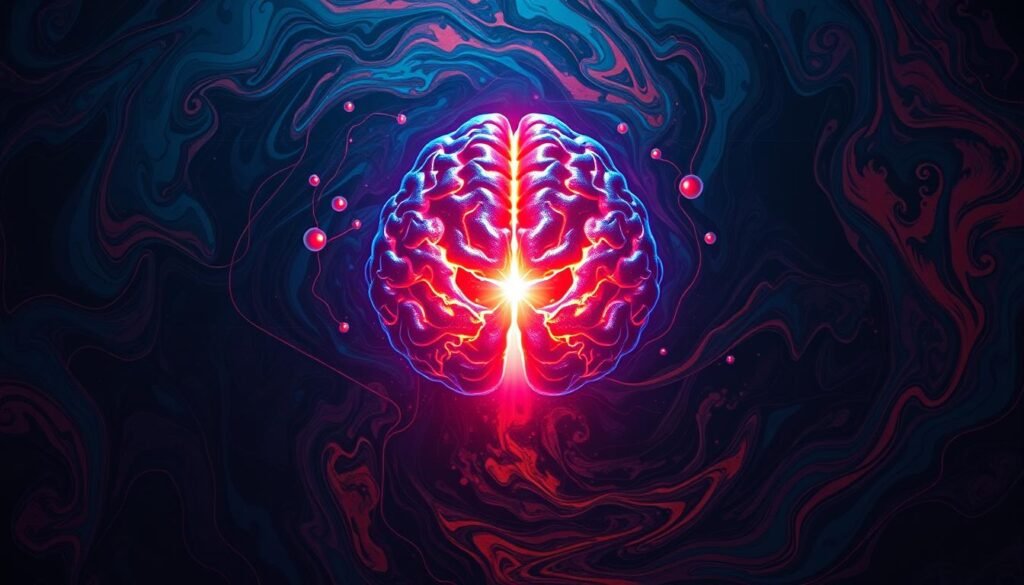Nearly 30% of adults in the United States will face an anxiety disorder during their lives. This highlights an urgent need for better treatment and deeper understanding. Neuroimaging techniques are creating big leaps forward in anxiety research.
Through brain imaging, such as fMRI and PET scans, scientists can see how anxiety works in the brain. They are learning about the neural mechanisms that play a role in anxiety disorders. This is uncovering important information about how the brain functions and its structure.
Brain imaging has shown different patterns of brain activity for various anxiety disorders. Studies have provided a window into the brains of those with generalized anxiety disorder and panic disorder. As more research is done, these findings will help improve diagnosis and treatments. This could help those suffering from anxiety disorders find relief and improve their mental health.
Key Takeaways
- Almost 30% of U.S. adults are affected by anxiety disorders.
- Neuroimaging techniques offer critical insights into brain function.
- Distinct activation patterns linked to various anxiety disorders have been identified.
- Ongoing research enhances diagnosis and treatment strategies.
- Advancements in brain imaging are reshaping our understanding of anxiety.
Understanding Anxiety Disorders
Anxiety disorders impact millions in the U.S. These conditions are marked by intense fear or worry. They harm people’s everyday lives. Anxiety comes in different forms like generalized anxiety disorder, panic disorder, social anxiety, and phobias. Each has its own symptoms and problems, affecting life quality.
To know if it’s an anxiety disorder, we must see if it’s more than normal worry. If anxiety stops you from doing daily tasks, you need help. Symptoms can show up in your body, like a fast heartbeat, tense muscles, or stomach problems. Spotting these early helps in treating them with therapy, medication, or even yoga.
Studies explain what causes these disorders. Problems in brain areas like the prefrontal cortex and amygdala are linked to anxiety’s impact. Knowing about these brain parts helps in creating better treatments. As we understand mental health better, recognizing and treating anxiety has gotten more important.
Many people have anxiety disorders, from 14.0% in Europe to 18.1% in the U.S. It’s crucial to know the different anxiety types and their specific challenges. This helps in finding the right diagnosis and treatments. For more details, the physical symptoms of anxiety offer insights into identifying and handling these issues.
The Role of Neuroimaging in Anxiety Research
Neuroimaging helps us understand anxiety disorders better. Techniques like fMRI and PET show us brain activity as it happens. This is key in spotting unusual brain patterns linked to anxiety.
About one in thirteen people suffer from anxiety globally, says the WHO. Brain scans let us look at special brain areas tied to feelings. For example, PTSD studies show odd activity in some regions, helping us see what goes wrong in the brain.
Looking into generalized anxiety disorder (GAD) reveals how the amygdala and prefrontal cortex connect. This is vital in figuring out the roots of anxiety. By studying how the brain reacts to fear, we can learn more about anxiety. This also helps create better treatments.
Through neuroimaging, we’re making strides in both neuroscience and psychiatry. It’s leading to new ways to help those with anxiety disorders. For more information, check out this detailed study.

Brain Imaging Studies on Anxiety
Brain imaging studies are key to learning about anxiety disorders. They use imaging techniques for anxiety research to look at changes in the brain. These include functional magnetic resonance imaging (fMRI) and positron emission tomography (PET). These methods show us how anxiety looks inside the brain.
Overview of Neuroimaging Techniques
fMRI is a standout imaging technique. It tracks changes in blood flow, showing which parts of the brain are active. Thanks to fMRI, we know which brain areas get involved when we feel anxious. Findings in the amygdala and other areas help doctors and researchers make better decisions about treatment.
Key Findings from fMRI Studies
fMRI studies have unveiled key facts about anxiety. They show the amygdala works overtime during scary situations. Brain imaging studies tell us that people with anxiety disorders react differently at the neural level. This is very helpful for creating treatments that are more personalized.

The Amygdala: A Central Player in Anxiety
The amygdala is key in handling emotions, especially fear and anxiety. People with anxiety disorders might see changes in how their amygdala works. This affects how they deal with anxious feelings and reactions. Knowing about the amygdala helps us understand behaviors linked to anxiety.
Understanding Amygdala Function
Studies show the amygdala is closely tied to our emotional responses. This makes it a major area of interest in anxiety research. Those with anxiety disorders often show more activity in their amygdala when facing stress. This can make fear and discomfort feel worse. Brain scans for anxiety disorders give important clues about this, helping us know more about emotional health.
Connectivity Patterns in Anxiety Disorders
In anxiety disorders, the amygdala connects differently with other brain parts. These links can vary by anxiety type, showing how complex these disorders are. For example, changes in amygdala connections might link to how severe symptoms are or how one copes. Understanding these links can help create better therapies for anxiety sufferers.

Research into these connections aims to enhance our knowledge of anxiety disorders. Such studies offer hope for better treatment methods. Those looking into this area can find in-depth info online. For instance, check out this resource.
Insights from PET Scans in Anxiety Research
PET scans for anxiety reveal key insights into how our brains deal with anxiety disorders. They show us various brain processes by visualizing metabolic activities. This makes PET scans unique among brain imaging techniques.
PET scans can track changes in brain activity over time. This is vital for understanding anxiety disorders better.
Comparison of PET and fMRI Techniques
PET and fMRI scans both provide important data on brain activity but in different ways. PET scans measure brain metabolism, showing neurotransmitter activity. fMRI scans, on the other hand, focus on blood flow changes.
This difference changes what information researchers get about anxiety. It helps them create more effective treatments.
Significant Results from PET Imaging Studies
Recent PET studies have found changes in neurotransmitters in those with anxiety disorders. They’ve seen a decrease in receptors like 5HT1A and benzodiazepine. This helps us understand more about anxiety’s root causes.
Many people feel more anxious during PET/CT scans. This shows how the scans can mirror our psychological states. PET scans’ insights help with both research and treatment options for anxiety disorders.
The Impact of Fear Conditioning on Brain Scans
Fear conditioning research tells us how scary experiences can affect our current fears. By using advanced brain scans and anxiety responses, scientists see how certain brain areas activate during fear. The amygdala, anterior cingulate cortex, and other parts of the fear network are crucial. They show us how different brain parts connect in the neuroanatomy of anxiety.
A study involved a mixed group of 304 people. This included 92 with anxiety disorders, 74 who had experienced trauma, and 138 who did not have these experiences. They went through several steps: fear learning, experiencing shock, learning to not respond to fear, and remembering that learning. This showed how parts of the brain involved in fear communicate with each other.
Brain imaging techniques show the amygdala is more active in certain anxiety issues. This includes post-traumatic stress disorder, social phobia, and specific fears. This activity links to strong memories created during fear learning. Understanding these brain areas helps in creating new treatments that target the root causes of anxiety.
Further research can improve treatments like exposure therapy. This therapy tries to change conditioned responses. By targeting brain changes, it can help people recover from tough anxiety. The findings from this research show how fear learning and anxiety responses are connected. They guide future studies and treatments for anxiety.
Neural Correlates of Anxiety Disorders
Research into anxiety shows how the brain’s complex networks impact our emotions. By understanding these networks, we get clearer insights into anxiety disorders. This opens the path to better diagnosis and treatments.
Mapping the Fear Network in the Brain
Experts explore the brain’s fear network, including areas like the amygdala and prefrontal cortex. They use neuroimaging to see how these parts interact when we’re anxious. For example, people with social and generalized anxiety disorders show specific brain patterns during social situations.
Changes in the prefrontal cortex and amygdala are key to our fear reactions. These findings come from looking at how different brain areas work together.
Implications for Diagnosis and Treatment
Understanding anxiety’s brain basis is crucial for treatment. It helps doctors create tailored therapies. For example, seeing how medications affect the brain can improve symptoms in people with social anxiety.
This knowledge leads to targeted treatments, making them more effective. It promises improved life quality for those with anxiety disorders. Advances in this area are giving many people new hope.
Recent Developments in Anxiety Imaging Studies
Recent studies on anxiety imaging have made big strides in our understanding of anxiety disorders. Thanks to advances in neuroimaging, researchers can look deeper into the brain’s workings related to these conditions. These advanced imaging techniques let us see the brain’s structure and function in great detail.
Innovative Approaches to Brain Mapping
New brain mapping methods combine different neuroimaging techniques. This gives a full picture of anxiety disorders. The findings show clear biotypes for various anxiety disorders and depression. This reveals how these conditions differ from person to person. For instance, one large study with 938 adults found six distinct biotypes, each with specific traits and brain circuit issues.
These discoveries lead to more accurate treatments. Now, we can tailor treatment to the individual, offering hope for better results. Personalized therapy and medications can make a real difference for those with anxiety disorders. It’s crucial to keep researching in this area. After all, these findings could change the lives of over 80 million American adults who suffer from anxiety.
Conclusion
Brain imaging has hugely improved our understanding of anxiety. It has revolutionized psychiatry. Studies using methods like SPECT, PET, and fMRI have revealed important details. For example, they’ve found that the amygdala and insula are often involved in anxiety disorders.
Such discoveries not only increase our knowledge but also help in creating better treatments. This can lead to improved outcomes for people with anxiety.
Looking ahead, anxiety research will benefit from new imaging technologies and methods. The Amen Clinics, known for diagnostic practices, have done nearly 50,000 SPECT scans. Using advanced statistical methods will make brain imaging even more specific. This will help us understand different psychiatric disorders better.
In conclusion, neuroimaging gives us critical insights into anxiety disorders. It helps in developing better diagnostics and treatments. As research continues, neuroimaging will be key in making life better for people with anxiety. It will push psychiatry toward a brighter future.